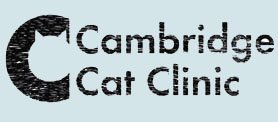12:15pm
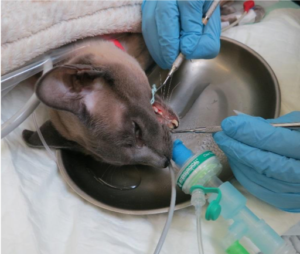 Now that all of the teeth have been descaled, the vet is able to fully assess how healthy each one is. At the same time, they can examine the gums and mouth, looking for signs that indicate dental and/or oral disease. The tartar often covers the tooth so it can’t be examined until this stage. The vet will use a periodontal probe to examine each tooth, checking probing depth (the depth of the area between tooth and gum – a gap, or pocket of more than 1mm indicates that the tooth may need to be removed). They are also looking for resorption lesions, areas of infection, tooth mobility, furcation exposure (when the area between the roots of multi-rooted teeth is exposed due to bone loss), fractured or missing teeth and periodontal disease (gingivitis and periodontitis).
Now that all of the teeth have been descaled, the vet is able to fully assess how healthy each one is. At the same time, they can examine the gums and mouth, looking for signs that indicate dental and/or oral disease. The tartar often covers the tooth so it can’t be examined until this stage. The vet will use a periodontal probe to examine each tooth, checking probing depth (the depth of the area between tooth and gum – a gap, or pocket of more than 1mm indicates that the tooth may need to be removed). They are also looking for resorption lesions, areas of infection, tooth mobility, furcation exposure (when the area between the roots of multi-rooted teeth is exposed due to bone loss), fractured or missing teeth and periodontal disease (gingivitis and periodontitis).
The Vet then records all of their findings on a dental chart. This is a crucial component of your cat’s medical history, and will be kept with their personal file for life.
12:20pm
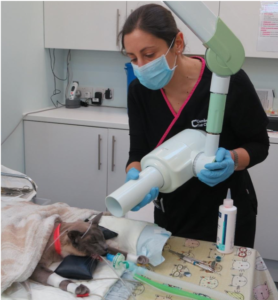 The next step is dental radiographs (x-rays). Cambridge Cat Clinic uses state-of-the-art digital dental radiography which provides us with clear, detailed pictures of our patient’s teeth, both above and below the gum line. Approximately 60% of a cat’s tooth is located below the gum line, so it is essential that dental radiography is used. Without x-rays we would miss a large number of diseased teeth, and would not be able to plan or carry out treatment properly. We wouldn’t try to fix a broken leg without taking an x-ray first, would we?
The next step is dental radiographs (x-rays). Cambridge Cat Clinic uses state-of-the-art digital dental radiography which provides us with clear, detailed pictures of our patient’s teeth, both above and below the gum line. Approximately 60% of a cat’s tooth is located below the gum line, so it is essential that dental radiography is used. Without x-rays we would miss a large number of diseased teeth, and would not be able to plan or carry out treatment properly. We wouldn’t try to fix a broken leg without taking an x-ray first, would we?
We often have cats visit us at the clinic who appear to have missing teeth on first examination, but when an x-ray is taken, the tooth roots are still in the cats mouth, causing pain and discomfort (these obviously then need to be removed!). Without the X-ray, these would be very hard to detect.
12:30pm
Luckily for McClane, this is his first ever dentistry surgery, so we get to take a fresh look at his mouth!
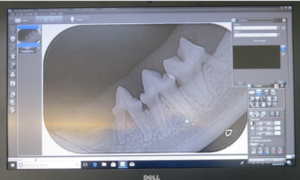 From the examination of the tooth and the x-rays that we have performed, the vet can see that tooth 409 (the right, mandibular molar) has established periodontal disease, causing loss of soft tissue and bone support, especially affecting the bottom of the root. She can also see that tooth 407 (another right, lower molar) has a “type 2 tooth resorption lesion” which has progressed to “stage 3” severity (deep dental enamel loss that extends into the “pulp cavity”, or nerve). Neither of these dental diseases are reversible and the damage will be causing pain, so both of these teeth need to be extracted!
From the examination of the tooth and the x-rays that we have performed, the vet can see that tooth 409 (the right, mandibular molar) has established periodontal disease, causing loss of soft tissue and bone support, especially affecting the bottom of the root. She can also see that tooth 407 (another right, lower molar) has a “type 2 tooth resorption lesion” which has progressed to “stage 3” severity (deep dental enamel loss that extends into the “pulp cavity”, or nerve). Neither of these dental diseases are reversible and the damage will be causing pain, so both of these teeth need to be extracted!
12:35pm
Having teeth removed is painful. As well as a lovely concoction of a pre-med including pre-emptive analgesia, the vet also now administers a local anaesthetic block to the mandibular nerve, which completely numbs the area around the teeth that are to be extracted. The local anaesthetic will last for 6-8 hours, so will carry on providing pain relief for several hours after surgery.
12:45pm
Once the local anaesthetic has had 10-15 minutes to reach full effect, the vet can begin the delicate, skilled procedure of extracting the teeth. Serious trauma and injury can be caused to the patient if this is not performed by a qualified, competent and experienced Veterinary Surgeon, and it should be noted that tooth extractions are never to be carried out by anyone other than a vet. Our vets usually wear loupes (like a jeweller’s magnifying glasses) as cats have very small teeth, with slender, brittle roots, and the specific instruments and suture material used for dentistry are very fine.
The vet uses a surgical flap technique to open the gum, exposing the bone around the tooth, to reveal root surfaces and allow a good repair after extracting the necessary teeth. A small amount of bone is removed from around the tooth roots to allow the vet to see the roots to be extracted. Teeth with more than one root are divided using a high speed, water-cooled drill. Tiny sharp instruments, precise technique and patience are need to stretch the periodontal ligaments and finally remove the tooth root. After extraction any rough bone is smoothed and the tooth socket is cleaned of any debris.

Once the teeth are successfully removed, post extraction radiographs are performed to ensure that all fragments of the tooth have been removed. The extraction sites are then flushed with saline and sutured (stitched up) with a dissolvable suture, to promote fast healing, and prevent any food or debris from becoming trapped in the hole where the tooth was, which can cause pain and infection.
1:05pm
The vet now polishes the remaining teeth, which helps to smooth the tooth surface, making it harder for plaque to accumulate. The mouth is then carefully rinsed out, and an oral mouth wash rinse applied, before the throat pack is removed.
1:10pm
McClane is then allowed to wake up quietly and slowly from his anaesthetic, whilst remaining cuddled up in the warm Bair Hugger blanket and we give him a nice groom (we imagine grooming yourself with a sore mouth is not very nice!). When ready, he is “extubated” (his endotracheal breathing tube is removed) and allowed to breathe oxygen and room air through a face mask.
1:20pm
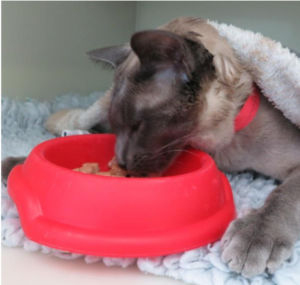
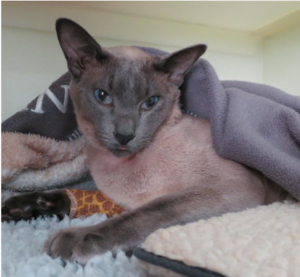 Once McClane is fully awake, and all monitoring and anaesthetic equipment has been removed, he is taken back to a hospital pod, temporarily separated from his brother, to recover. We monitor him closely whilst he is in recovery – this is one of the most crucial periods for post-anaesthetic complications.
Once McClane is fully awake, and all monitoring and anaesthetic equipment has been removed, he is taken back to a hospital pod, temporarily separated from his brother, to recover. We monitor him closely whilst he is in recovery – this is one of the most crucial periods for post-anaesthetic complications.
1:30pm
McClane is now ready for his belated breakfast, which he eats very enthusiastically (and with surprising ease, despite his mouth being a little numb after the local anaesthetic block).
1:40pm
McClane continues to recover under close supervision, whilst Mojo is prepped ready for his own dentistry procedure. Despite having significant gingivitis (inflamed gums) present throughout his mouth, Mojo’s teeth only showed early or mild periodontal disease. With no problems identified in his radiographs, treatment with scaling and polishing above and below the gumline was performed and no extractions were needed.
Both boys had several teeth with probing depths of 1mm, so it will be very important for them to receive home dental care (tooth brushing) to prevent these teeth from requiring extraction in the future.
2:45pm

The brothers McClane and Mojo have been reunited, and are tucking into their second breakfasts of the day. Now that they have both recovered well from their surgeries, their owner is phoned to update them that all had gone very well, and to arrange a discharge appointment for later that day.
6pm
Their owners are here to collect them. The vet meets with the boys’ owners to discuss the day’s surgeries, explaining the findings from the radiographs, and providing verbal and written aftercare instructions. As McClane had multiple extractions, he has been given a bottle of pain relief and anti-inflammatory medication, to take at home for the next few days.
Once their intravenous catheters have been removed, temporary pressure bandages applied, and identification collars removed, the brothers are transported into their carriers, and into Reception, ready to go home.
The vet has asked them to come back in 10-14 days for a recheck appointment, but sooner if they have any concerns.
10-14 days later
The brothers are back for their recheck appointment with the vet. They have recovered very well, and the surgical extraction sites in McClane’s mouth are healing nicely. The vet now takes this opportunity to speak to the owners regarding home dental care, and the options available which may suit the personalities and temperaments of the Tonkinese brothers. Prevention of periodontal disease is aimed at controlling plaque. As you can imagine, some cats will tolerate tooth brushing, whereas others certainly will not, so a plaque-repelling granule or oral mouthwash may be more suitable. McClane and Mojo’s owners will be sent a reminder in 6 months to invite them back for a recheck appointment, to see how their mouths are looking.
